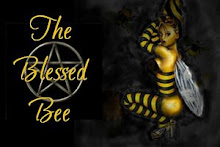If one word could best describe the Georgian Tradition, it would be 'eclectic. Even though the material provided to students was nominally Alexandrian, there was never any imperative to follow that path blindly. George Patterson (the tradition's founder) always said 'If it works use it, if it doesn't, don't'. The newsletter was always full of contributions from people of many traditions.
2.19.2009
Wiccan Traditions: Georgian Wicca
Posted by The Blessed Bee at 10:58:00 PM 0 comments
Labels: Georgian Wicca, information, magic, Neo-Pagan, New Age, Pagan, traditions, wicca, Wiccan traditions, witchcraft
Wiccan Traditions: Gardnerian Wicca
This is a closed initiatory Tradition which was founded in England in 1953 by Gerald Gardner and further developed by Doreen Valiente and others. Gardner was allegedly initiated into a coven of Witches in the New Forest region of England in 1939 by a High Priestess named 'Old Dorothy' Clutterbuck.
In 1949 he wrote High Magic's Aid, a novel about medieval Witchcraft in which quite a bit of the Craft as practiced by the coven was used. In 1951 the last of the English laws against Witchcraft were repealed (primarily due to to the pressure of Spiritualists) and Gardner published Witchcraft Today, which set forth a version of rituals and traditions of that coven.
Gardner gave his Tradition a ritual framework strongly influenced by Freemasonry and Crowleyan ceremonial magic, as well as traditional folk magic and Tantric Hinduism. The Tradition was brought to the USA in 1965 by Raymond & Rosemary Buckland, who were initiated in 1964 by the Gardner's High Priestess, Lady Olwen. Since his "outing," it has been argued that whether he was initiated into an ancient coven or not, most of the Gardnerian system is not ancient at all (see Origins of Wicca). Rather, Gardner created his system from his work with ceremonial magick and Aleister Crowley, studies of the OTO and Golden Dawn, and literature by writers such as Charles Leland, Robert Graves, and Margaret Murray.
Nevertheless, he is responsible for bringing witchcraft back out of the broom closet and gave birth to the modern form we call "Wicca." Gardnerian covens are always headed by a High Priestess and have three degrees of initiation closely paralleling the Masonic degrees. Worship is centered on the Goddess and the Horned God. The tradition emphasizes polarity in all things, fertility, and the cycle of birth-death-rebirth. Eight seasonal Sabbats are observed, and the Wiccan Rede is the guiding principle. Power is raised through scourging and sex magick ("The Great Rite"), as well as meditation, chanting, astral projection, dancing, wine and cords. Designed for group/coven work, through solitary workings have been created. Covens work skyclad.
Posted by The Blessed Bee at 10:52:00 PM 0 comments
Labels: Gardnerian Wicca, Gerald Gardner, information, magic, Neo-Pagan, New Age, Pagan, wicca, Wiccan traditions, witchcraft
Wiccan Traditions: Feri Wicca
Victor and Cora Anderson are the original teachers of the Feri Tradition. Victor is universally recognized as the Grand Master of his order of Feri. He was initiated in 1926 by a priestess from Africa. He is also one of the last genuine Kahuna. His book of poetry, Thorns of the Bloodrose, is considered a contemporary Pagan classic. I
n 1959, Victor initiated the late Gwydion Pendderwen (age 13 at the time), who later became a leading voice in the Feri Tradition. Gwydion concentrated on the Welsh Celtic aspects; whereas Victor and Cora still practice the tradition as it was originally, with Huna and African diasporic influences, primarily Dahomean-Haitian.
Starhawk was also trained in the Feri tradition and draws on it heavily in her Reclaiming system.
The Feri Tradition honors the Goddess and Her son, brother and lover (The Divine Twins) as the primary creative forces in the universe. The Gods are seen as real spirit beings like ourselves, not merely aspects of our psyche. It is an ecstatic, rather than fertility tradition, emphasizing on polytheism, practical magic, self-development and theurgy.
Strong emphasis is placed on sensual experience and awareness, including sexual mysticism, which is not limited to heterosexual expression.
Posted by The Blessed Bee at 10:49:00 PM 0 comments
Labels: Feri Wicca, information, magic, Neo-Pagan, New Age, Pagan, Starhawk, Victor Anderson, wicca, Wiccan traditions, witchcraft
Wiccan Traditions: Faery Wicca vs. Faery Witchcraft
A loose association of covens and solitaires who have a respect for the Faerie Folk in common. This type of Wicca works with the fey in a fairly traditional Celtic Wicca frame.
Faerie Witchcraft, on the other hand, is also a loose association of people who practice Faerie magick and work with the Faerie realm, but do not use a Wiccan format and are more shamanic/ecstatic in nature.
Many Faerie Witches also consider themselves Welsh Witches (see Welsh Witchcraft).
Posted by The Blessed Bee at 10:47:00 PM 0 comments
Labels: faerie folk, Faery Wicca, Faery Witchcraft, information, magic, Neo-Pagan, New Age, Pagan, shamanism, Welsh Witchcraft, wicca, Wiccan traditions, witchcraft
Wiccan Traditions: Eclectic Wicca
Eclectic Wicca refers to groups and individuals not following any one particular Tradition or mythos, but incorporating elements of several, according to the training, preferences and experiences of the practitioners. Deities from several pantheons may be invoked, sometimes even in the same ritual, particularly when a working is being created for a specific cause. In such a case, Eclectics may call upon an assortment of Love Goddesses, etc. from many different cultures. This is the fastest growing branch of Wicca today, due to the large number of books available and the shortage of traditional covens who have room for new students or enough elders willing to hive off.
Posted by The Blessed Bee at 10:45:00 PM 0 comments
Labels: Eclectic Wicca, information, magic, Neo-Pagan, New Age, Pagan, wicca, Wiccan traditions, witchcraft
Wiccan Traditions: Dianic Wicca
There are two distinct branches of Dianic Wicca: The first Dianic coven in the U.S. was formed in the late '60s by Margan McFarland and Mark Roberts, in Dallas, Texas. This branch gives primacy to the Goddess in its theology, but honors the Horned God as Her beloved Consort. Covens include both women and men. This branch is sometimes called 'Old Dianic,' and there are still covens of this tradition specially in Texas. Other covens that are similar in theology but not directly descended from the McFarland/Roberts line are sprinkled around the country.
The other branch, Feminist Dianic Witchcraft, focuses exclusively on the Goddess and consists of women-only covens, often with a strong lesbian presence. These tend to be loosely structured and non-hierarchial, using consensus decision making and simple, creative, experimental ritual. They are politically feminist groups, usually very supportive, personal and emotionally intimate. For both branches rituals are eclectic; some are derived from Gardnerian and Faery traditions, while others have been created anew. Emphasis is on rediscovering and reclaiming female power and divinity, consciousnes-raising, and combining politics with spirituality.
Posted by The Blessed Bee at 10:43:00 PM 0 comments
Labels: Dianic Wicca, feminism, Goddess, information, magic, Neo-Pagan, New Age, Pagan, wicca, Wiccan traditions, witchcraft
Wiccan Traditions: Ceremonial Wicca
Ceremonial Wicca uses a great deal of Ceremonial Magick in practices; mostly derived from the works of Aleister Crowley. Detailed rituals with a flavor of Egyptian magick are popular, as are Qabalistic ritual forms.
Posted by The Blessed Bee at 10:38:00 PM 0 comments
Labels: Ceremonial Wicca, information, magic, Neo-Pagan, New Age, Pagan, traditions, wicca, Wiccan traditions, witchcraft








